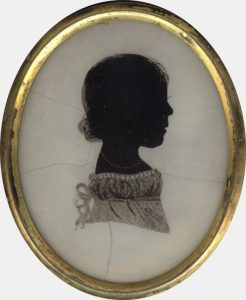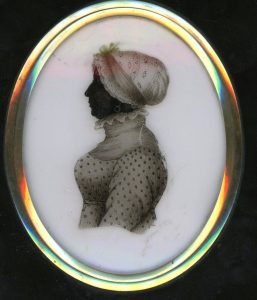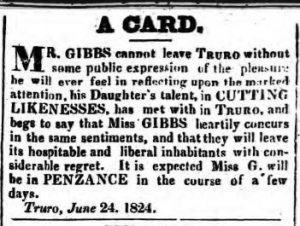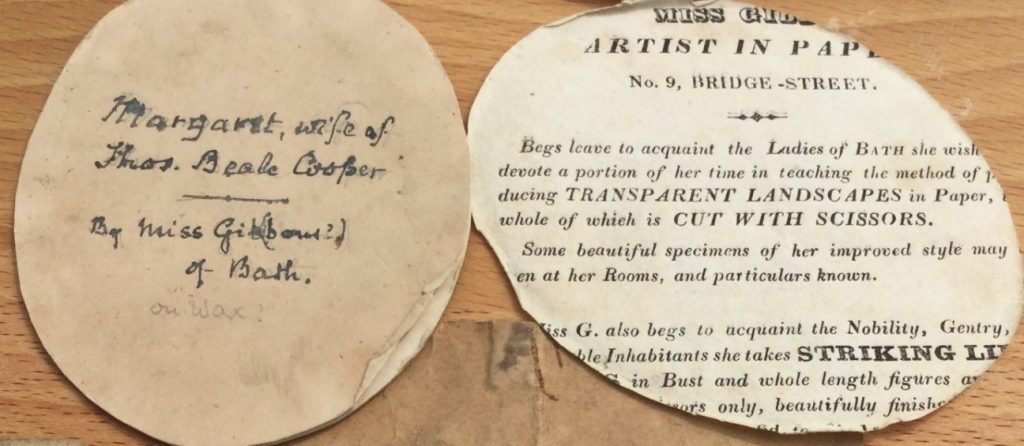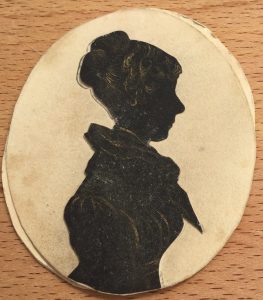Hinton Gibbs & Miss Gibbs
Silhouette collectors will be familiar with the name Hinton Gibbs and his distinctive profiles reverse painted on glass and backed with wax. But apart from his service in the Bedfordshire Militia, little else has been known about his background and family.
Similarly, Miss Gibbs who was recorded by Sue McKechnie as a cutter of silhouettes on the strength of two advertisements in the West Briton in June 1824. No examples of her work had been seen by her nor had the relationship between Hinton and Miss Gibbs been confirmed.
Recent research in public records and other sources has brought some new evidence to light, allowing the following chronology to be constructed:
- 31 December 1783 – Baptism of Hinton born to John & Sarah Gibbs, alehouse keepers in Bedford
- 1786 – Birth of sister Sarah (There was possibly a second son, John, who went on to be a sadler.)
- February 1793 – Re-embodiment of the Bedfordshire Militia under the command of Colonel The Earl of Upper Ossory; Hinton Gibbs is listed in the Militia Rolls as a drummer. He would have been ten years old.
Between 1793 and 1799 the militia was based in Essex and East Anglia before marching south to Kent and then on to Sussex and the south coast where they operated until September 1798. In 1796 Hinton is listed as a Private. They are then sent to Ireland where they remain for a year before returning to Bedford in the autumn of 1799. By now Hinton has been away from home for nearly seven years.
- 1800-01 – Hinton is listed as a Corporal in 1800. In May the Militia march to Taunton where they are stationed until September. They then spend a month near Exeter before being posted to Plymouth. In November 1801 the men are ordered back to Bedford where the Militia are to be disbanded. They march a total of 254 miles in 17 days in what was the severest winter on record.
Hinton’s earliest known works as a profilist date from this period, so he was likely using his skills to supplement his income as evidenced by one of his early trade labels “By H. Gibbs, Beds. Militia”.
- 1803-04 – In March, amid fears of a new attempt at invasion by Napoleon, the Bedford Militia is re-embodied and Hinton reverts to the rank of Private. In May they march to Bristol where they stay a year, then to Taunton where they rest before going on to Aylesbeare and moving into winter quarters in Exeter.
On 3rd December 1804 Hinton marries Eliza Sanders in the church of St. Thomas the Apostle, Exeter. The 1851 census gives her birthplace as Exeter but no record of her birth has been traced.
- 1805-07 – Quartered at Exeter until March, the militia subsequently moves around South Devon spending the winter and spring at Ottery St. Mary before being sent to Gosport. In August 1806 a detachment that includes Hinton is sent to the Isle of Wight. Hinton’s wife accompanies them and the couple’s first child, Sarah, is born in Freshwater in January 1807. Hinton may have been recalled to Gosport before the birth as by October 1806 the garrison is stationed at Fort Monckton.
- 1808 – The militia is stationed at Winchester for duty during the Assizes before being sent to Weedon in Northamptonshire where they are quartered in newly built barracks.
- 1810-12 – Ordered to Hastings; during August 1810 they participate in a Review at Brighton in the presence of the Prince of Wales (later George IV). In December the regiment go to Horsham Barracks for the winter and then to Littlehampton until April 1812.
Hinton & Eliza’s second child, named Eliza, is born during 1810 and christened at the Wesleyan Methodist Chapel in Harpur Street, Bedford.
- April 1812 – the militia make a speedy journey from Littlehampton to Norman Cross near Peterborough where their main duty is guarding French prisoners.
- 1813-14 – With things kicking off in Ireland, they are ordered to make their way to Bristol with utmost speed for embarkation.
By now Eliza is heavily pregnant again so she remains in Bedford where she gives birth on 7 July 1813 to their first son christened Hinton on 30 August at the Wesleyan Methodist Chapel in Harpur Street, Bedford.
Meanwhile, the Bedford Militia arrive in Roscommon in August 1813 and remain until July 1814 when they return to Colchester. In December 1814 they move to Ipswich.
- 1815 – The militia are ordered back to Bedford where they are disembodied on 1 February 1815.
When Hinton is discharged his eldest daughter Sarah would have just celebrated her eighth birthday and baby Hinton would have been eighteen months old. It is at this point that Hinton becomes a full-time profilist working from various addresses in London but also touring (with his family) as evidenced by an advertisement on 1 November 1815 in the Bury and Norwich Post. Based at Sudbury. Hinton acknowledges “the friendly, hospitable and generous treatment” he and his family have received.
- 1816 – The couple’s second son is born on 4 January and baptised James on 12 April at the Wesleyan Methodist Chapel in Harpur Street, Bedford. Hinton’s profession is given as ‘limner’.
- 1819 – A third son is born on 26 June and baptised John at the Wesleyan Methodist Chapel, Scarborough.
Presumably Hinton was now working in Yorkshire though no adverts have yet been traced. An ‘H Gibbs’ is paying Land Tax during this year as the occupier of a house in Green Man Lane, Islington.
- 1821 – A third daughter, Harriet Emma, is born.
Hinton is working in Oxford as evidenced by a lengthy (and somewhat boastful) advertisement in the Oxford University & City Herald (27 October 1821). At this point he is charging 15s. for a framed profile. A further brief notice appears in the same newspaper on 17 May 1823.
- 1824 – Hinton is working in Cornwall and is for the first time actively promoting the work of his daughter (presumably 17 year old Sarah rather than 14 year old Eliza) who, unlike her father, is cutting silhouettes as shown by an advert placed in the Royal Cornwall Gazette (26 June 1824).
A further notice appears in the same newspaper on 23 October 1824 when she is working in Falmouth.
- 1825 – During this year there are four known adverts for Miss Gibbs:
North Devon Journal (27 May, 3 June, 10 June)
Taunton Courier (21 Sept)
The advert of 3 June includes a price list and indicates the range of cut work now offered by Miss Gibbs from plain busts for 1s 6d through to conversation pieces. Interestingly, profiles on glass are also offered though it seems likely that these were still being painted by Hinton who was by then still in his early forties.
- 1829 – No further adverts have been traced until the Huntingdon, Bedford & Peterborough Gazette (1 August 1829).
This is the advert that finally confirms that Miss Gibbs is the daughter of Hinton Gibbs. She is now back in her father’s home town of Bedford and has diversified into Oriental Tinting, a fashionable painting technique that involved transferring a drawing with oriental (aka tracing) paper to velvet, paper or other surface, and working up the colours to the desired brilliancy. Because the design was traced, it appealed to talented amateurs.
- 1839 – Hinton Gibbs dies in Astbury, Cheshire on 27 March aged 56. He may have travelled there to visit family. There is a record of a Susannah Gibbs born in Astbury in 1827; other Gibbs born there subsequently moved a few miles north to Stockport.
- 1841 – Hinton’s sister, Sarah, is living in Mercer Street, Long Acre along with her recently widowed nephew, John, and his daughter Helen Hinton Gibbs, aged 4.
Hinton’s wife, Eliza (Betsy), is living in Chapman Street, Islington with four of her six children: Hinton Jr (a clerk), Eliza, James (a clerk) and Harriet. - 1845 – Hinton’s daughter Harriet Emma marries W. H. Smith, a newsagent (not that one!)
- 1847 – Hinton & Eliza’s daughter Eliza marries the boy next door, A. J. Wright, a clerk, who is ten years younger than her.
- 1851 – Hinton’s wife Eliza, aged 67, is living at 33 Freeling St with a female servant; her daughter Eliza is living in the same street at no. 18 with her husband, his two brothers, and his mother.
- 1853 – Hinton Jr. emigrates with his family to Australia where he dies in 1877.
Miss Gibbs & Her Work
It would appear that, unlike her father, Miss Gibbs did not use a trade label though she did print hand bills to advertise her presence as she toured, and her work. An example of a handbill used in Barnstaple in 1825 has come to light offering a variety of styles from plain bust silhouettes for 1s 6d up to coloured work on glass starting at 10s 6d and rising to £1 11s 6d. In all likelihood these more expensive options would have been executed by Sarah’s father.
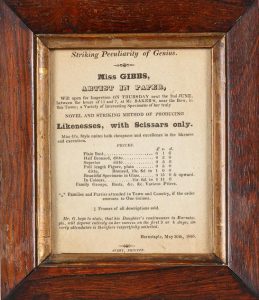
No example of her work has hitherto been recorded. A second incomplete handbill used in Bath shows that cut paper landscapes had been added to her repertoire!
Two loose silhouettes accompanied the handbill but as they differ in style they appear to be cut by different hands. It’s therefore unclear which of the two was actually cut by Miss Gibbs.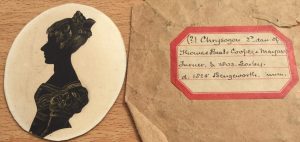
Sarah’s body of work was probably quite small as she ceased working as a silhouettist upon her marriage to Bedford-born Francis Herbert in December 1830. Herbert was a solicitor with a thriving practice in London. The couple resided at Chelsea and had a large family of four daughters and six sons. Sarah died in 1864 whilst still only in her fifties; her husband outlived her by eleven years.
© Wigs on the Green
